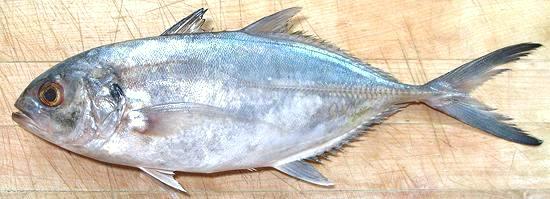 [Bluestripe Jack, Hardtail Jack, Egyptian Scad; Caranx crysos]
[Bluestripe Jack, Hardtail Jack, Egyptian Scad; Caranx crysos]
Belonging to the same family as Pompanos, Blue Runners are found close to coasts and reefs on both sides of the Atlantic and in the Mediterranean. They range from the southern tip of England to Angola, and from Nova Scotia, Canada, to northern Brazil, including the Gulf of Mexico and the Caribbean. They can grow to nearly 28 inches and 11 pounds, but the photo specimen was fairly typical at 14 inches and weighing 1 pound 1-1/2 oz. This fish is a minor commercial catch, and is IUCN rated LC (Least Concern).
More on Jacks & Trevally.
Blue Runner is not considered a prime market fish, due to the high amount of dark meat, and dealing with the scutes, so it is available at a very good price. The majority of the flesh is medium color and has a good medium flavor, but the dark streak down the center is both wide and deep, with a stronger flavor. While I find this quite acceptable, it will not be favored by neophytes who want their fish "white and lite".
The flesh is very tender raw, but firms up with cooking, so it's suitable for wet cooking. The flesh flakes apart easily on the plate. Fillets work fine pan fried skin-on with a light dusting of rice flour, but for poaching I prefer fillets skinned, as the skin becomes mushy with wet cooking.
Warning: The row of hard scutes along the lateral line at the tail needs to be cut away before cooking - just the straight part, they are no bother from the start of the curve forward. If not removed, they will come loose in cooking and make your eating experience much less enjoyable. They will also interfere with skinning if you wish to skin fillets.
Buying: This fish is often available in the Philippine markets. Filipinos are quite accustomed to dealing with fish others may consider difficult. The photo specimen was purchased from a Philippine market in Los Angeles (Eagle Rock) for 2016 US $1.99 / pound.
Scales: Blue Runner scales are tiny and easy to scrape off without any flying about. I suggest cutting out the hard scutes at the tail at this point. Make a shallow cut under them from both sides and peel off as a strip.
Cleaning: Nothing unusual here, except the body cavity extends a ways aft of the vent. The throat is tough and will have to be cut with kitchen shears. Use your long nose pliers for pulling the gills.
Fillet: This fish fillets easily, having a coherent bone structure to follow. Handle gently, as the flesh is very tender when raw. I start by cutting off the head, as this fish will not usually be cooked head-on. When you get to the rib cage, cut the ribs from the backbone with kitchen shears and pull them from the fillet with long nose pliers - they will almost fall out of the tender flesh. There are substantial centerline pin bones for the length of the body cavity, which must be pulled out straight forward.
Skin: The skin has little shrink when heated, so fillets can be fried skin-on. Fillets can even be poached skin-on, but I prefer not, as the skin becomes mushy. The skin is easy to remove using the standard long knife and cutting board Method. The main problem is the skin at the tail end will be cut in half by removing the scutes, making it fragile and very difficult to hold on to. Consider starting skinning from the top point of the front.
Yield: A 1-1/2 pound fish yielded about 12.2 ounces of skin-on fillet (51%), and 11 ounces of skinless fillet (46%).
Stock: Head bones and fins make a good medium flavored stock with little oil. I have not included skins when making stock from this fish. Remove what oil there is using your gravy separator. For details see our Fish Stock page.
Health & Nutrition In the Virgin Islands reef environment, larger fish, probably well over 14 inches, have been reported to cause ciguatera poisoning.
sf_runbz 090828 r 160730 - www.clovegarden.com